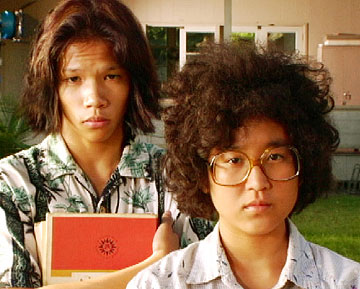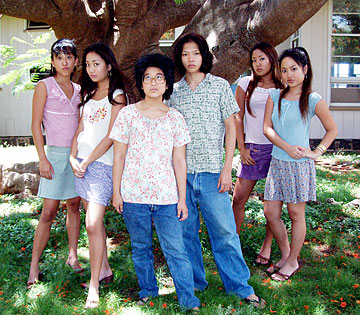'Fishbowl' hooks PBS spot
Kayo Hatta's short film is about Waialua plantation town life in 1975
WATCHING the late Kayo Hatta's work on what turned out to be her final film, it's tough to shake the feelings of what was and what might've been.
The short film "Fishbowl," based on a story from Lois-Ann Yamanaka's breakout book, "Wild Meat and the Bully Burgers," shows Hatta's affinity for depicting characters trying to find their way through trying times. In this way it is much like the Japanese immigrant workers of her 1995 independent feature debut, "Picture Bride," the audience award winner for best dramatic film that year at the prestigious Sundance Film Festival.
"Fishbowl"
Premieres 8 p.m. Thursday on KHET/PBS, and repeats 10 p.m. May 9 as part of PBS's national "Independent Lens" series.
|
A decade later, Hatta's work finally reappears with this 30-minute film, which airs Thursday on PBS Hawaii. ("Fishbowl" premiered during last fall's Hawaii International Film Festival.)
Hatta's accidental drowning last July in California unfortunately prevents us from seeing how her film vision would've matured. But in the meantime we can appreciate what she did accomplish, on a limited budget, in this adaptation of Yamanaka's coming-of-age story.

COURTESY THE FISHBOWL PROJECT
Billy Lam, left, as Jerry, and Mie Omori as Lovey, play outcasts to Jordan Mukai's popular girl Lori in "Fishbowl," a short film by Kayo Hatta.
|
|
It's a slice-of-life portrait of Waialua plantation town life set in 1975. Halloween is approaching, and two outsider adolescent friends -- Lovey and Jerry (Mie Omori and Billy Lam) plan to go to the town party as their favorite singers, the Captain and Tennille. Their classmates (and class rivals), the stuck-up Japanese girls of the social club Rays of the Rising Dawn, are constant reminders of how they'll never be "cool."
Lovey, burdened in her appearance with a bad perm and large glasses, knows she'll never be the Rays' equal. She even resents a bit that Jerry might be the club's "honorary dreamboat" because of his hairstyling and dancing skills.
Plus, she finds it difficult to "pretend talk haole" to her teacher's satisfaction because of her pidgin English.
"Fishbowl" pulls back the pidgin just a bit for better play for a wider audience. Omori remembers how long it took to film Lovey's dramatic ending monologue just because of that.

COURTESY THE FISHBOWL PROJECT
Jerry, left, and Lovey in "Fishbowl."
|
|
"I did 12 takes for that speech," the 17-year-old said by cell phone during a break from a journalism convention in San Francisco last week. "It was draining. I felt I was going to break down, going through so many emotions. And even though I really liked the first take, Kayo chose to use another one. ... What happened is that I had to work on making it understandable but keep the anger the same throughout. The first take was more intense because it was more pidgin."
BOTH SHE and Lam, who had never acted before, were not originally cast as Lovey and Jerry. Omori knows Yamanaka personally, a former student of "her little school, Na'au, with her partner Mel Spencer," and auditioned for "Fishbowl" as an extra. Lam's theatrical experience was as a dancer with the Hypersquad Dance Company.
"I didn't audition. Kayo basically wanted a younger-looking guy with long hair," Lam, a senior at Kaimuki High School, said. "She came to one of the dance concerts I did, saw me, and she said, 'I need him for my movie.' A week later, I was doing the part of Jerry."
"Billy was a lot of fun to work with," Omori said. "He's a really great dancer, really nice, and made you feel welcome. He took the whole thing in stride, like 'OK, I'm the new guy, I won't give everyone a hard time.'"
"Even though it was my first acting experience, it was easier to do it with Mie," Lam said. "I really liked her. She's an original person."

COURTESY THE FISHBOWL PROJECT
Kayo Hatta, shown here on the set, died in an accident last year.
|
|
That "original person" is an Iolani School student and was at the Bay area national journalism convention because she'll be the new editor of the school newspaper, Imua Iolani, in her junior year. (She's also contributed to the school's creative-writing magazine, Mane O Ke Ola.)
"It seemed such a great opportunity to try something new," Omori said of her acting. "And the wig and glasses were really huge! I actually wore them to school one day, totally hoping it would help me get into character. In fact, the girl who played the head Ray said, 'Now I understand why I wouldn't want you in the club. You look so ugly, in a warped way!
"Everyone feels like an outcast at one time or another. I see so many people who get victimized by 'popular people' who either rise above it or cringe. And it's not just kids."

COURTESY THE FISHBOWL PROJECT
The cast of "Fishbowl," where Mie Omori, third from left, and Billy Lam, to her right, contrast sharply to popular girls of the social club Rays of the Rising Dawn.
|
|

